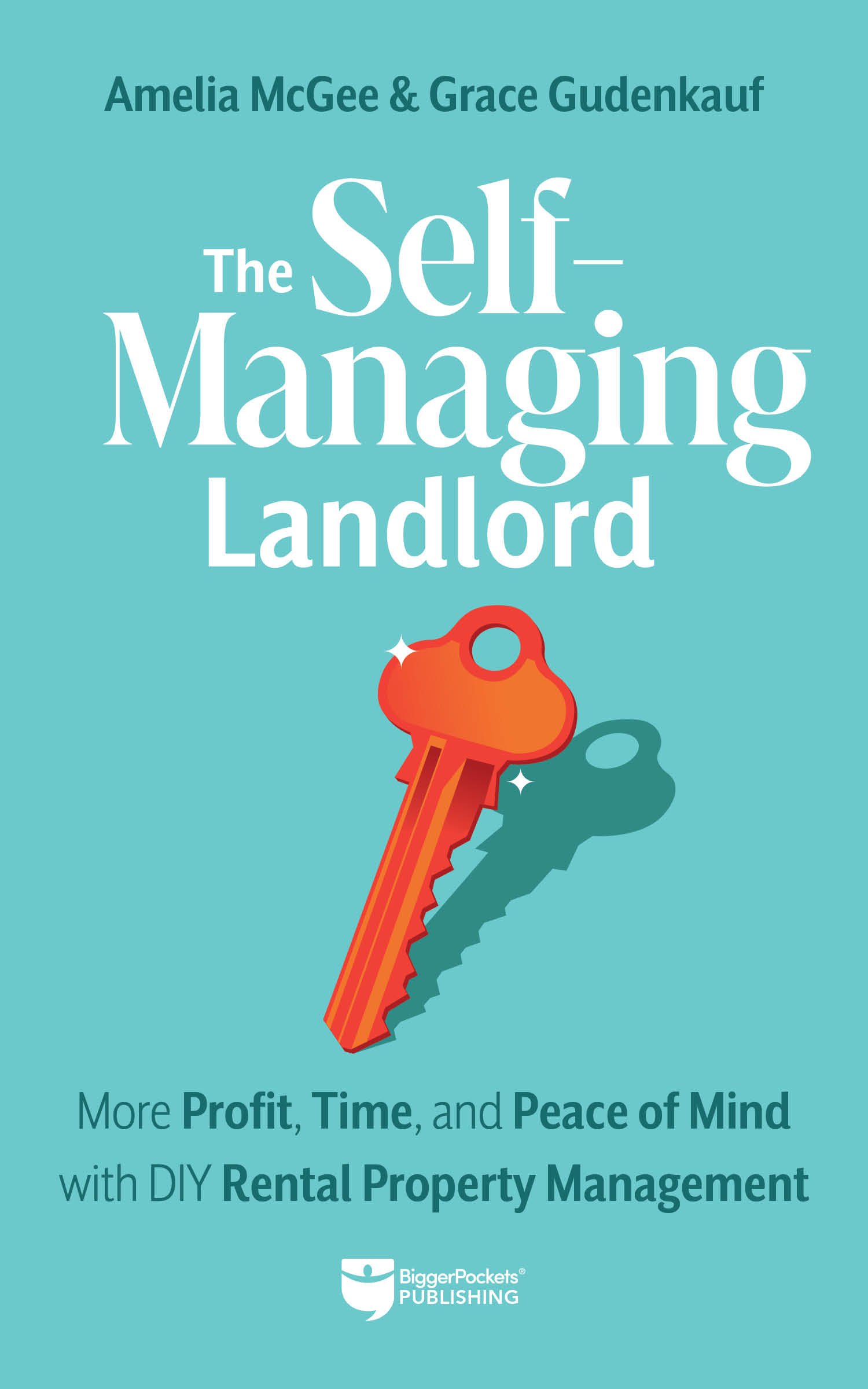Does this scenario sound familiar?
“I distinctly remember a conversation I had with my boyfriend shortly after submitting an offer on my very first rental property. We were sitting at his son’s Little League baseball game, and my mind was wandering (if you’ve ever watched a Little League baseball game, you understand). I turned to my boyfriend and said, ‘What happens if they actually accept my offer on that property?’
The truth of the matter was, I was a 28-year-old with not even an ounce of rental property or landlording experience. All I knew was that I was over working a 9-to-5 W-2 job and thought that real estate investing could be my path out. Ever the black-and-white, straight-to-the-point kind of guy, my boyfriend responded with, ‘You’ll figure it out.’ Little did I know how true that statement would turn out to be.”
That’s Amelia McGee, co-author of The Self-Managing Landlord with Grace Gudenkauf, explaining her anxiety and fear as a soon-to-be DIY landlord.
To Self-Manage or Not To Self-Manage—That is the Question
Like many first-time real estate investors, Amelia found herself diving into the world of property management with little experience and plenty of uncertainty. Self-managing a rental property can be daunting, but it also offers significant benefits—greater control, potential cost savings, and hands-on learning. However, it comes with its own set of challenges, from tenant management to handling maintenance issues.
Based on real-life experience and insights from Amelia and Grace, we’ll explore the advantages and challenges of being a self-managing landlord.
The Benefits of Self-Managing Your Rental Property
Self-managing your rental property offers unique advantages that can significantly enhance your investment experience and increase your profits. Here are four key benefits of self-managing that can positively impact your bottom line.
1. Cost savings
One of the most significant advantages of managing your rental property yourself is the potential to save a considerable amount of money. Property management companies typically charge 8% to 12% of the monthly rent for their services, along with additional fees for tenant placement, maintenance, and lease renewals. By self-managing, you can avoid these fees and keep more rental income for yourself, thereby increasing the profitability of your investment.
Let’s look at an example from The Self-Managing Landlord that shows how much you may need to pay a property manager. In this scenario, we assume a property is rented for $1,700 a month and was purchased for $170,000—following the 1% rule.
| Service | Cost |
| Account setup fee | $300, one time |
| Management fee | $170 per month (10% of monthly rent) |
| New tenant placement fee | $850, one time (50% of monthly rent) |
| Maintenance fee | $100 per request (assume three per year) |
| Annual total | $3,490 ($290 per month) |
Looking at the breakdown here, you can see that after setup, management, placement, and maintenance fees, you can expect to pay about $3,500 yearly in property management fees. That’s more than two months’ rent!
Granted, that cost will reduce in the second year, assuming the tenant renews their lease. However, these charges will still eat into your cash flow potential.
2. Quality control
When you self-manage, you have direct control over the maintenance, tenant selection, and overall condition of your property. This is especially important for ensuring your investment is well-maintained and your tenants are satisfied. Property management companies often manage multiple properties, so your rental might not get the attention it deserves.
The Self-Managing Landlord explains why some mom-and-pop landlords may be dissatisfied with the quality of service they receive from property management companies:
The most common recurring issue I hear from investors who are using a property management company is that they don’t feel like their property is getting enough attention, or that the property management company doesn’t really care about them after their contract is signed.
Let’s think about this from a macro view of the property management industry. Most property management companies are only making $100 to $200 of recurring revenue per month on every property they manage. These are thin margins in the grand scheme of things. In order to run a profitable business, pay their employees, and cover other business expenses, these property management companies need to onboard hundreds of clients, which in turn spreads their efforts out too thin.
This issue is further exacerbated if you only have a few properties with the management company. Their main priority is going to be their bigger clients, so the smaller you are, the further down the ‘call back’ list you’re going to be.
3. Better tenant relationships
This level of control allows you to build relationships with your tenants, leading to longer retention and reduced costly turnover. Direct communication fosters trust and respect. Tenants appreciate landlords who respond quickly to maintenance requests and are approachable when issues arise.
Also, by being more involved in the tenant screening process, you can ensure that you select responsible tenants who are likely to stay long-term and take care of the property.
4. Build valuable skills
Managing a property on your own teaches you a wide range of valuable skills, from handling maintenance and repairs to negotiating leases and managing finances. These skills can be beneficial, not only for your rental properties, but also for future business ventures.
In fact, in the book, Amelia shares an experience about how she partnered with other investors to purchase a $500,000 property. They brought the cash for the down payment, and she brought her skills as a successful DIY landlord. It was a win-win for everyone.
The Challenges of Self-Managing Your Rental Property
Self-managing rental properties can be rewarding, but doing so also comes with several challenges that every landlord should consider. The Self-Managing Landlord mentions these five key areas where self-managing can present difficulties.
1. Managing tenants
Handling tenant relations is one of the most critical aspects of being a self-managing landlord. Even if you try to build tenant relationships, mismanagement can lead to disputes, vacancies, or even legal issues.
Educating yourself on landlord-tenant laws and best practices is essential to avoid problems. Proper tenant screening, addressing tenant concerns, and ensuring rent is paid on time are crucial. Although most tenants are reasonable, there will always be a few who challenge your patience, requiring tact and professionalism to manage effectively.
2. Managing contractors
Property maintenance is another vital responsibility, and it requires finding, hiring, and coordinating contractors for repairs and upkeep. Poor contractor management can lead to cost overruns, substandard work, and decreased property value.
Knowing how to negotiate contracts and oversee projects is crucial to maintaining tenant satisfaction and your property’s overall quality.
3. Handling emergencies
Emergencies, such as plumbing leaks or electrical issues, can happen anytime. As a self-managing landlord, you may not always be available to respond immediately, which can lead to property damage or unhappy tenants.
A reliable emergency response plan is essential to ensure that urgent situations are dealt with swiftly and effectively.
4. Problem-solving
Managing a rental property can be emotionally taxing, especially when tenant relations or property issues arise. Letting personal feelings cloud your judgment can negatively impact your decision-making process.
According to The Self-Managing Landlord:
“One of the most important skills you need to have as a self-managing landlord is the ability to problem-solve. Landlording may not be the right fit for someone who quits when the going gets tough or does not react well to stress or pressure…You need to decide whether it’s really worth it for you to continue landlording or if hiring it out is the better option.”
Successful self-managing landlords must maintain professionalism, set clear boundaries, and remain objective when interacting with tenants and property concerns. Creating systems and processes to minimize emotionally driven decisions can help ensure consistency in your management approach.
5. Legal risks
Self-managing landlords must be well-versed in local, state, and federal landlord-tenant laws. Failure to comply with legal requirements can result in costly disputes, fines, or evictions. Staying up-to-date on legal developments and seeking legal counsel when needed is crucial for managing risks appropriately.
Final Thoughts
While these challenges are real, you should still be able to self-manage your properties. At the same time, they remind you that the proper knowledge and preparation can help you navigate potential difficulties.
By thinking through worst-case scenarios and being proactive, you can make informed decisions and prevent many issues from arising. Remember, even without prior experience, many successful landlords have learned as they go—proving that you can effectively manage your rental properties and see positive results with the right tools and mindset.
Save time and money with this refreshing guide to managing your own properties.
In The Self-Managing Landlord, Amelia McGee and Grace Gudenkauf share the secrets of efficient property management, tenant screening and onboarding, and scaling your business—all to help you break free from the 9-to-5 grind and create lasting wealth through real estate.
Note By BiggerPockets: These are opinions written by the author and do not necessarily represent the opinions of BiggerPockets.




